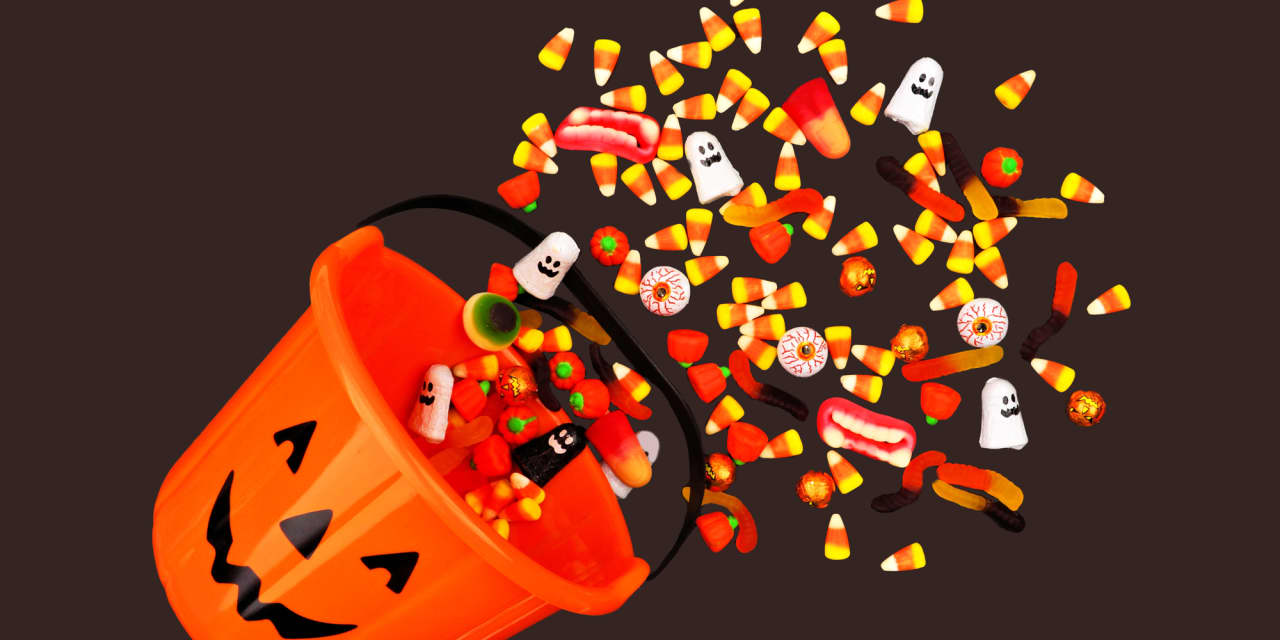It’s the spookiest day of the year, and trick-and-treating remains the most popular way to celebrate Halloween. But this year, costumed children might expect to get fewer pieces of candy.
Prices for nearly everything in the household have risen, and candy is no exception. As of September, the price of candy and gum has increased 7.5% from a year ago and is up by 21.6% from 2021’s Halloween season, according to the Bureau of Labor Statistics. That is a climb not only steeper than inflation overall, but also the price gains in general grocery items.
Other data suggest the “spookflation” might be even more severe. Market intelligence firm Datasembly tracks weekly changes for grocery items at more than 150,000 stores nationwide and over 200 retail banners that span over 30,000 zip codes across the U.S.
Its data suggest that candy prices are up by 13% from October 2022, more than double the growth in overall grocery prices. The price gain is even higher in Northeastern states like Pennsylvania and Maryland.
The particularly higher price tags for candy have been driven by a spike in the costs of their key ingredients.
Thanks to the hot and dry weather, Mexico, where America imports much of its sugar from, has seen its production fall by more than 15% this year, according to the Department of Agriculture. High cost of fertilizers and labor didn’t help.
The futures of raw sugar on global markets has gained 50% from last year, now trading at the highest level since 2011.
Candies with chocolates have had it even worse. Heavy rains and a rot-causing disease in West Africa, which accounts for two-thirds of the world’s cocoa bean harvest, have wreaked havoc on the crops this year.
Unlike sugar, which can be produced from multiple crops like cane or beets, there is no easy alternative for cocoa. Futures for the commodity recently hit $3,880 a metric ton, 67% more than a year ago and the most expensive since the 1970s.
Snack companies including
Nestlé
(Switzerland: NESN),
Chocoladefabriken Lindt & Spruengli
(Switzerland: LISN) , and
Hershey
(HSY), have recently said that they won’t rule out the possibility of further price hikes.
Despite being squeezed by inflation, consumers’ desire for a festive Halloween has never been stronger. According to a recent survey from the National Retail Federation, 73% of the respondents said they’ll participate in Halloween-related activities this year, up from 69% in 2022 and the highest share since 2018.
Across all categories including candies, costumes, and decorations, people plan to spend an average of $108.24 for Halloween this year, a record high that beats the previous watermark of $102.74 in 2021.
The total Halloween spending is expected to reach $12.2 billion this year, exceeding last year’s record of $10.6 billion. Spending on candy is expected to take nearly 30% of the pie, reaching $3.6 billion. That’s a 16% uptick from last year.
“More Americans than ever will be reaching into their wallets and spending a record amount of money to celebrate Halloween this year,” said NRF President and CEO Matthew Shay in a statement.
But higher spending doesn’t necessarily mean more candy—it might simply be driven by the expensive prices.
Retail consulting firm
Advantage Solutions
recently surveyed 1,000 U.S. adults who celebrate Halloween and serve as their household’s primary grocery shopper. Two out of five of respondents said that inflation will impact their plans to buy Halloween candy.
Within that group, half expect to spend the same amount of money, but buy less candy due to higher prices, and one third anticipate spending less from last year. Only one in six said they plan to pay more to account for higher prices.
“The effect of surging prices and persistent inflation on Halloween shopper spending is undeniable,” said Andy Keenan, executive vice president of retail services for Advantage Solutions, in a statement announcing the survey results.
Despite soaring cocoa costs, chocolate remains the crowd favorite. Nearly 90% of candy buyers say they’ll be eating or treating others to chocolate candy, followed by gummies and sour candy, with 60% and 45%, respectively.
In its latest earnings report for the quarter ended on Oct. 1, chocolate giant Hershey reported 10% growth in North America’s confectionery sales, but organic volume slipped by 1% from the previous year, suggesting people are dialing back on their sweet tooth.
Investors will be closely watching the numbers this Halloween to spot any signs of further softening demand. Hershey shares have slumped 33% over the past six months.
Write to Evie Liu at [email protected]
Read the full article here










